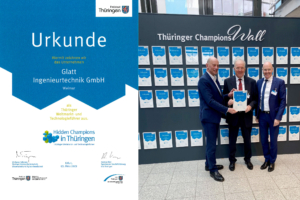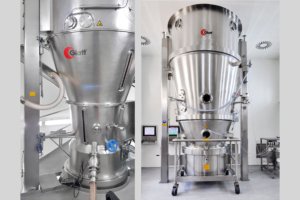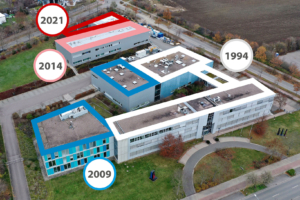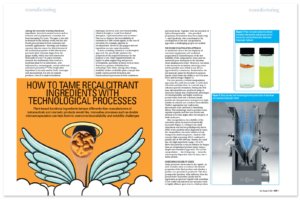Festive inauguration of the Dryflux facility. The participants (from left to right): Jay Nowak, CEO Glatt Group, Economics Minister of Thuringia, Wolfgang Tiefensee (SPD) Jeff White, Head of the Surface Solutions business unit within the Electronics business sector of Merck, and Weimar’s Mayor, Peter Kleine (independent)
All-in-one process and plant operation: Glatt joins forces with Merck for cosmetic pigment production
On 30 June 2023, a completely new type of production plant for special effect pigments was officially commissioned at the Glatt Technology Centre. The Dryflux technology is suitable for numerous powder applications.
Weimar, June 2023 – The pigment specialists at Merck and the technology and production experts at Glatt Ingenieurtechnik have worked closely together to produce an innovative range of cosmetic pigments using completely new technology. The Darmstadt-based Merck Group placed the order for the development and construction of a plant based on chemical vapour deposition (CVD) after successful joint trials at Glatt’s highly suitable location in Weimar.
Since September 2022, the patent-pending Ronaflux® pigments have been produced by Glatt in Weimar for the Darmstadt-based science and technology company Merck. Glatt was commissioned by Merck to develop the plant technology and install the complete production facility, which is owned by Merck. Glatt then became operational there, fulfilling its role as a contract manufacturer of Ronaflux® pigments for Merck. Construction of the plant began in 2020 and stands on 74 m2 of floor space, extended over 2.5 floors.
At the official commissioning ceremony of the plant on 30 June 2023, Jeff White, Head of the Surface Solutions business unit within the Electronics business sector of Merck, and Thuringia’s Minister of Economic Affairs Wolfgang Tiefensee were joined by Weimar’s Lord Mayor Peter Kleine, Dr Arnuf Wulff representing the State Development Corporation of Thuringia, and IHK Chief Executive Dr Cornelia Haase-Lerch.
Why Merck produces in Weimar
Merck and Glatt have enjoyed a successful partnership for many years, during which time Glatt has been manufacturing systems for Merck’s Healthcare and Life Science sectors.
Ronaflux® pigments are cosmetic products whose manufacture requires special quality and purity standards. Thanks to investment subsidies from the Thüringische Aufbaubank in recent years, it was possible to create ideal conditions for such processing requirements at Glatt’s Weimar Technology Centre. Glatt was thus able to expand its technological portfolio to include the development and application of high-temperature process technology based on fluid bed and powder synthesis. This meant that the necessary infrastructure was already in place at Glatt or could be expanded quickly and cost-effectively. As a plant and process specialist, Glatt has the corresponding know-how required to set up a production plant for Ronaflux® pigments.
First productive CVD system on this scale
Dr Michael Jacob, Head of Process Technology Food, Feed & Fine Chemicals at Glatt, says: “A CVD on this scale is new and a prototype – there is not another plant like it. And it was developed, designed, built and commissioned in a relatively short time.” Jacob attributes the success of this project in part to the interplay of strengths within Glatt Ingenieurtechnik: “Not only were we able to draw on outstanding R&D resources here, but also the technological synergies from high-temperature process engineering and our many years of expertise in plant engineering. The basic technology was already available through successful R&D activities.” Here, Glatt benefits, among other things, from the results of a joint project of the regional development cluster “Thuringian Particle Design pades”, which was funded by the Federal Ministry of Education and Research.
Jacob continues: “This development would not have been possible without our expertise in pharmaceutical engineering for the planning and realisation of cleanroom projects for GMP production, and also in the cosmetics sector. We are not only plant constructors, but also operators and producers. And we are problem solvers too, with the challenges involved with the commissioning quickly identified and resolved thanks to great team work. The cooperation with Merck was and is characterised by trust, constructive cooperation and partnership.”
Dryflux technology
This technology creates a new class of special effect pigments that have a very colour-intensive and metallic shine. These unique effects are based on thin carbon layers on the pigment surface. The Dryflux technology is flexible and universally applicable to many powdered materials to meet customised customer requirements. A second validation phase for further products is currently underway, in which, among other things, the fluidisation behaviour of new raw materials will be evaluated and supporting parameters, such as pulsation, adjusted to the respective product.
Most important manufacturing steps
First, the pigment powder is vigorously stirred up in the reactor with an inert gas and thereby heated to the required reaction temperature. Next, the formation of thin carbon layers around the powder particles begins with the introduction of a carbon-containing gas into the reactor, that is then decomposed. Once all the powder particles are evenly coated with a carbon layer, the product is cooled, sieved and packaged under strict hygienic conditions.
Further information on this topic and related topics can also be found in the following publications:
March 2023: Glatt Ingenieurtechnik honored as a “Hidden Champion” made in Thuringia
September 2021: New fluid bed options for solvent-based processes and products
March 2021: Glatt Ingenieurtechnik celebrates continued business success with third expansion of its Technology Center
Published article: ‘With short time-to-market from process development directly to contract manufacturing’ PDF, English Reprint
Published article: ‘How to Tame Recalcitrant Ingredients with Technological Processes’ PDF, English








 Copyright: Jens Lehnert, Thüringer Landeszeitung
Copyright: Jens Lehnert, Thüringer Landeszeitung